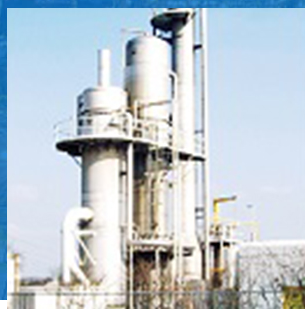1、工藝性質(zhì)不同
1. Different process properties
干法工藝是指那些在脫硫過(guò)程中煙氣始終保持干態(tài)的工藝,除了爐內(nèi)噴鈣外,都要求以生石灰作為吸收劑。濕法脫硫原理是指在脫硫過(guò)程中煙氣處于或部分時(shí)段處于飽和狀態(tài)的工藝,用于濕法的吸收劑主要是石灰石,氨、氧化鎂等也可用來(lái)作為吸收劑。
Dry process refers to those processes that keep the flue gas dry during the desulfurization process. In addition to calcium injection in the furnace, quicklime is required as the absorbent. The principle of wet desulfurization refers to the process in which the flue gas is saturated or partially saturated during the desulfurization process. The absorbent used for wet desulfurization is mainly limestone, and ammonia, magnesium oxide, etc. can also be used as absorbent.
2、技術(shù)特點(diǎn)不同
2. Different technical characteristics
濕法脫硫技術(shù)指的是,反應(yīng)劑在漿液狀態(tài)下進(jìn)行脫硫和脫硫產(chǎn)物的處理。濕法脫硫的主要設(shè)備包括噴淋塔和液柱塔脫硫系統(tǒng);干法脫硫工程是指以石灰為脫硫吸收劑,采用噴霧形式進(jìn)行脫硫處理。在吸收塔內(nèi),被消化并加水制成的石灰魯劑被霧化成細(xì)小液滴,與煙氣混合接觸,使煙氣中的SO2發(fā)生化學(xué)反應(yīng)成CaSO3,煙氣中的SO2被脫除。
Wet desulfurization technology refers to the treatment of desulfurization and desulfurization products by the reaction agent in the slurry state. The main equipment of wet desulfurization includes spray tower and liquid column tower desulfurization system; The dry desulfurization project refers to the desulfurization treatment in the form of spray with lime as the desulfurization absorbent. In the absorption tower, the lime slurry which is digested and added with water is atomized into small droplets and mixed with the flue gas to make the chemical reaction of SO2 in the flue gas into CaSO3, and the SO2 in the flue gas is removed.

3、成分原料不同
3. Different ingredients and raw materials
干法脫硫劑的主要成分是生石灰和水配制成的乳狀脫硫劑(氫氧化鈣)。濕法脫硫主要利用石灰石或石膏漿液洗滌煙氣,使其與SO2反應(yīng)生成亞硫酸鈣(CaSO3)。分離的亞硫酸鈣可以被廢棄,或者可以強(qiáng)制進(jìn)入空氣中氧化,并且可以添加一些添加劑以石膏形式回收
The main component of dry desulfurizer is the emulsion desulfurizer (calcium hydroxide) prepared by quicklime and water. Wet desulfurization mainly uses limestone or gypsum slurry to wash flue gas and make it react with SO2 to generate calcium sulfite (CaSO3). The separated calcium sulfite can be discarded or forced into the air for oxidation, and some additives can be added for recovery in the form of gypsum
4、吸收劑不同
4. Different absorbents
干法脫硫使用的吸收劑可分為鈣基和鈉基兩種,吸收劑可以是干的、濕的或漿狀的。煙氣在反應(yīng)器中照射后,煙氣分解產(chǎn)生大量的氫氧和氧原子,促進(jìn)煙氣中二氧化硫和氮氧化物生成硫酸和硝酸,再與氨水反應(yīng),形成硫酸銨和硝酸銨的混合物,用作農(nóng)用肥料。
The absorbents used for dry desulfurization can be divided into calcium base and sodium base. The absorbents can be dry, wet or slurry. After the flue gas is irradiated in the reactor, the flue gas decomposes to produce a large number of hydrogen and oxygen atoms, promoting the formation of sulfuric acid and nitric acid from sulfur dioxide and nitrogen oxides in the flue gas, and then reacts with ammonia water to form a mixture of ammonium sulfate and ammonium nitrate, which is used as agricultural fertilizer.
濕法脫硫一種是采用吸收性能好、易于再生的氧化鎂作為吸收劑吸收煙氣中的SO2。采用兩個(gè)除塵器串聯(lián),以除去煙氣中的小粉塵顆粒,再生后的氧化鎂可以作為吸收劑再利用;另一種是以氨水為吸收劑,吸收煙氣中的二氧化硫,其中間產(chǎn)物為亞硫酸銨和亞硫酸氫銨。采用不同的方法處理中間產(chǎn)物,回收硫酸銨、石膏、單體硫等副產(chǎn)物
One kind of wet desulfurization is to use magnesium oxide with good absorption performance and easy regeneration as absorbent to absorb SO2 in flue gas. Two dust collectors are connected in series to remove small dust particles in the flue gas. The regenerated magnesium oxide can be reused as absorbent; The other is to use ammonia water as absorbent to absorb sulfur dioxide in flue gas, and the intermediate products are ammonium sulfite and ammonium bisulfite. Use different methods to treat intermediate products and recover by-products such as ammonium sulfate, gypsum and monomer sulfur
5、性?xún)r(jià)比不同
5. Different cost performance
濕法脫硫反應(yīng)速度快,效率高,技術(shù)比較成熟,生產(chǎn)運(yùn)行安全可靠,始終占據(jù)主導(dǎo)地位,但產(chǎn)生的生成物較難處理,能耗高,占地面積大,設(shè)備龐大。干法脫硫相對(duì)于濕法脫硫來(lái)說(shuō)完全相反,設(shè)備簡(jiǎn)單,占地面積小,投資運(yùn)行費(fèi)用較低,操作方便,能耗低,生成物便于處置,無(wú)污水處理。
Wet desulfurization has fast reaction speed, high efficiency, relatively mature technology, safe and reliable production and operation, and always occupies the leading position, but the generated products are difficult to treat, high energy consumption, large floor area, and huge equipment. Compared with wet desulfurization, dry desulfurization is completely opposite, with simple equipment, small floor area, low investment and operation costs, convenient operation, low energy consumption, easy disposal of products, and no sewage treatment.
